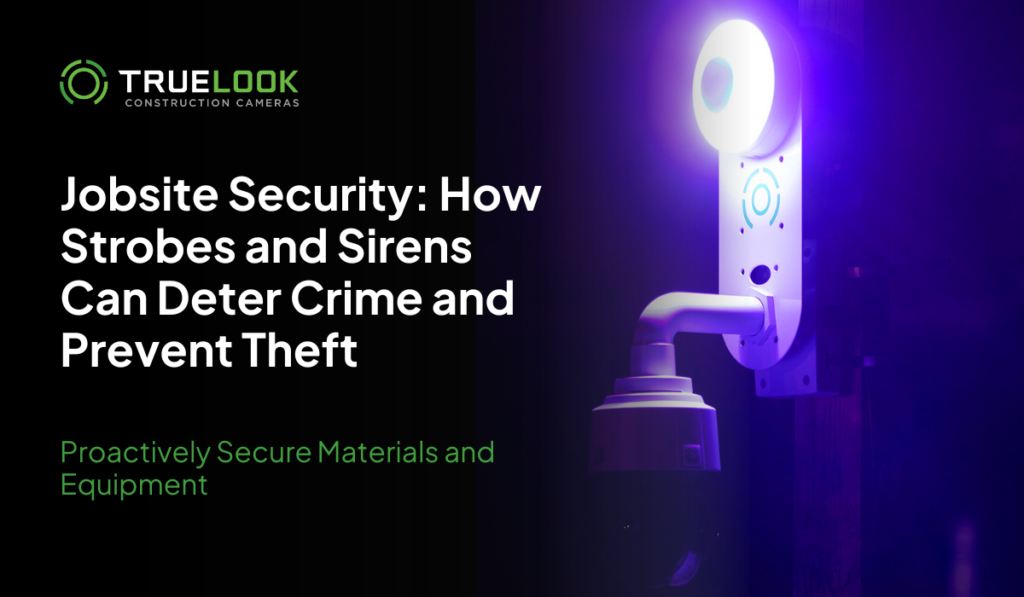
Safeguarding your jobsite is an essential task that can prevent costly headaches, protect your valuable equipment and materials, and avoid the frustrating delays that often come with jobsite theft.
In 2016, the National Equipment Register estimated that the cost of equipment theft can vary anywhere from $300 million to $1 billion per year, with less than a quarter of stolen equipment and materials ever being recovered. More recently in 2021, an increase in construction jobsite thefts in Pikes Peake, Colorado totaled more than $1 million dollars of lost equipment in that region alone.
These unexpected losses can be detrimental to contractors and construction firms, and they often lead to increases in expenses – meaning that ultimately, everyone from builders to clients will pay.
Fortunately, there are several solutions builders can employ to mitigate risks and increase their projects’ safety, one of which is strobes and sirens. These combination camera-and-audiovisual-alarm security systems can play a crucial role in deterring crime on jobsites and can even help with common insurance requirements.
3 Reasons to Use Strobes and Sirens on Your Jobsite:
Increased Camera Visibility
In today’s world, surveillance cameras are everywhere, but they are often made to blend seamlessly into their surroundings. When it comes to securing your jobsite, camera visibility is crucial. By ensuring that your cameras are easy to see, you send a clear message to potential criminals that their actions are being watched and recorded.
When investing in proactive security for your jobsites, look for a camera system that features a regularly-blinking strobe light. A visual signal like this can make intruders think twice before tampering with your project.
Proactive Crime Deterrence
Despite the presence of visible cameras, some determined criminals may still attempt to steal from or vandalize your jobsite. This is when strobes and sirens go into full effect. Think of these systems as having different responses to different threat levels – the higher the threat, the more strobes and sirens will do to deter it.
On some strobes and sirens systems, the aforementioned blinking light may change to rapid flashes when the camera detects motion within its field of view. In some cases, this visual alarm may be enough to scare away unwanted nighttime visitors.
If the security unit utilizes real-time monitoring, this is when a professional monitoring agent reviews the video clip from the camera to see if the threat is real or a false alarm (for example, an animal walking across your site). Should they verify an active threat to your project, there are a few actions they can take.
The first would be to activate the sirens, which should be fairly loud (be sure to check your local noise ordinances to ensure your system won’t break the allowed decibel level). The siren alarm is likely to send criminals running away, but just in case it doesn’t, the monitoring agent may also then contact law enforcement to come to your jobsite.
Some security systems may be able to activate the siren alarm and alert law enforcement automatically, but it’s recommended to use one that works in tandem with real-time monitoring. A siren blaring over and over throughout the night may annoy those living nearby and could result in noise ordinance violations. Plus, you may be fined for bothering the police with too many false alarms, and your requests might be seen as less of a priority.
Meeting Insurance Requirements
Securing adequate coverage is an essential part of any construction project, and many insurance carriers require specific security measures to be in place to provide coverage. Strobes and sirens can fulfill some of these requirements, serving as an audio-visual deterrent on your jobsite.
By implementing this solution, you will not only meet insurance criteria but will also gain access to the features of the camera on the system (such as live viewing and video documentation, which can help in the event of an insurance claim). If you’re not sure what type of camera you should be looking for, check out our guide to choosing the right construction camera. Remember, just because it’s a security system doesn’t mean that the camera can only be used for security purposes.
Be proactive in securing your assets, sites, and peace of mind.
Jobsite theft, vandalism, and other unauthorized access can lead to frustration, financial losses, and project delays. To defend your projects effectively, it’s crucial to invest in proactive security measures.
TrueLook’s security solution includes a high-definition fixed-position or PTZ camera with night vision capabilities, flashing strobe lights, and blaring sirens to deter unwanted visitors away from your projects. These systems require Jobsite Surveillance to verify motion alerts, activate the alarms, and dispatch authorities upon request, helping fulfill common insurance compliances that require real-time monitoring, strobes, and sirens.
By incorporating these security measures, you can get back to focusing on what matters most: delivering successful projects on time, within budget, and of the highest quality. Learn more about securing your jobsite and contact the TrueLook team today for a free demo. For more reading on valuable construction news and tips, check out our blog!
Get Powerful Peace of Mind
TrueLook’s Intelligent Security has your jobsite protected at all times.

